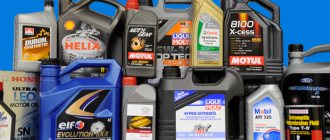Is mixing different motor oils allowed? This question is relevant for both novice motorists and experienced drivers. The main problem is that today there are many lubricants with additives and additives on the market. The number of manufacturers amounts to dozens, and the motor oils themselves differ in classes, categories and proprietary set of additives in the composition.
What will happen to the engine if you mix different lubricants? To answer this question, we can say that different oils can be mixed, but with some reservations.
General rules for mixing motor oils
The rules below can be used as instructions that should be followed if it is necessary to add oil to the power unit, which may differ in manufacturer, marking and type.
Follow these guidelines:
- Do not degrade the quality of the oil. It is prohibited to pour mineral water into synthetic or semi-synthetic oil. The ban also applies to adding “semi-synthetics” to “synthetics”. Deterioration in quality can cause negative reactions and reduce the effectiveness of supplements.
- In a situation where, for various reasons, you had to add poorer quality oil to your car, it is not recommended to heavily load the engine and exceed the speed. You need to move without forcing in order to protect the power unit from damage and extend its life.
- If mixing different oils was unavoidable, as soon as possible it is advisable to drain the resulting composition and refill with new lubricant. In this case, you only need to pour the oil that is recommended by the manufacturer.
- If possible, never mix mineral water and synthetic water, regardless of the manufacturer or other factors. In this case, the additives that were in the synthetic oil lose their effectiveness and precipitate. This feature can cause damage to the motor. Diluting a synthetic product with a mineral one is even more dangerous.
- You cannot fill the power unit with oil of different classes, for example, mix the lubricant of cars and trucks. To do this, you need to know the meaning of engine oil.
- It is not advisable to mix the oil in a 1 to 1 ratio. The maximum volume of added liquid is no more than 15% of the total volume.
- If you can’t find oil from one manufacturer, rely on the tolerances. It is important that they are identical for both products. For example, according to ACEA and API requirements, all oils are very similar in structure and quality. This means that you can mix them with each other and not worry about the result. If the fluid does not meet the standards, it simply will not pass the test. It is important to replace the resulting mixture as quickly as possible.
- If it is necessary to top up lubricant, it is better to use a product from the same manufacturer, albeit with individual viscosity parameters. But pay attention to seasonality. Otherwise, the viscosity of, for example, winter oil can be reduced, which can lead to engine contamination. In addition, when adding oil with a lower viscosity, waste consumption may increase, which requires more frequent level monitoring.
And now in more detail.
Rules for mixing lubricants in gearboxes
If everything is done correctly, the unit will not be damaged. When adding lubricant to the box, follow these rules:
- If you are afraid that the main fluids will be incompatible, use petroleum products manufactured by the same company. Different manufacturers use different techniques. The exact composition has not been disclosed. Therefore, when switching to mixed oil, it is better to use products from the same manufacturer.
- If there is no other way out, you can add motor oil to the gearbox, which has viscosity characteristics that differ from the product already filled. The main thing is brand consistency. When the oil level reaches the emergency line, you don’t have to think long, especially if you need to immediately drive on. Adding another lubricant is reminiscent of implantation. You need to get rid of it before it is rejected by the unit. Mixed oils should not be used constantly.
- When changing car oil, a car enthusiast does not completely get rid of used lubricant. Approximately five to ten percent remains in the aggregate. The remains of the old consumable are mixed with the oil being poured. Because of this, the characteristics of the new motor oil differ from those written on the canister label. If you want to use your car to its full potential, you need to perform several fills.
Inexperienced drivers who have never changed the car oil themselves are advised to go to a car service center. Its qualified employees will carry out all procedures themselves. If you know how to change oil, make an inspection hole in your own garage (for your own safety). You will need to buy an oil filter, which is replaced along with the car oil.
Differences between synthetic, semi-synthetic and mineral formulations
When considering the issue of mixing different types of oils, it is necessary to understand their characteristics.
Let's briefly look at the main differences:
- “Mineralka” is made from natural oil through selective purification. With proper operation, it can last about 4000-5000 km. It is distinguished by its affordable price and versatility of use.
- “Semi-synthetics” are oils containing artificial and natural components, namely mineral and synthetic types of lubricants. The average service life is 7000-8000 km. Such oils are universal, have high protective qualities and a relatively low price.
- “Synthetics” are the most durable option for motor oils, capable of serving 10,000-15,000 km. The products contain only artificial ingredients. The lubricant is of the highest quality and has a high price. Throughout its service life it shows a high degree of fluidity and viscosity.
As noted, it is not recommended to mix these types of oils due to the possible occurrence of dangerous chemical reactions. The result may be a decrease in service life and deterioration in engine performance.
The main harm comes from additives
If only mineral and synthetic oil bases were mixed, then, perhaps, much less damage would be caused to the engine than what is produced by the different chemical composition additives found in these oils. The fact is that not all additives contained in mineral oil dissolve in the synthetic base. Just as not all “synthetic” additives can dissolve in the mineral oil base. No one can predict what can happen in each individual case of mixing such oils. One thing is certain - the engine will be ill from such a “cocktail”. It’s bad, first of all, from the elements of the additives of the oil that were added – it doesn’t matter whether it’s mineral or synthetic – that have precipitated into an insoluble precipitate.
This undissolved sediment can form a viscous mixture that will clog the oil receiver grids and oil channels, causing the engine to experience oil starvation.
Operating in this mode, even for a short period of time, can lead to failure of the unit. It must be remembered that oil of a certain composition (mineral or synthetic) forms chemically modified layers and adsorbed films on the rubbing surfaces of engine parts. When other additives are added, these layers are destroyed, and wear of parts increases, which also significantly harms the engine.
Composition of lubricants
Any engine oil contains a base and additives that ensure the preservation of the necessary fluidity, protection against rust and other useful characteristics.
Each manufacturer uses an individual approach when creating a composition that is reliably protected from competitors.
It is formed taking into account the research conducted, and not only additives are taken into account, but also their ratio.
Often, an increase in the content of one element can cause a decrease in the effectiveness of another additive. This is an important point to remember.
There are often statements on the Internet that manufacturers’ statements about the impossibility of mixing different oils are a hoax, and the main goal is to increase sales.
In fact, the manufacturers themselves do not have experience in mixing different commercial oils; their job is simple: mix the formulations according to the developed instructions; they simply do not have the necessary capacity for other tests.
And the development of oils is carried out by additive manufacturers: Infineum, Lubrizol, Chevron and others.
In practice, products from different companies contain additives with a unique composition. If they come into contact during mixing, the risk of a reaction increases. The latter can be dangerous for the motor.
If we are talking about products from one company, there is a high risk of imbalance of beneficial components in the oil, and this also negatively affects its effectiveness.
In the case of mixing different types of oils, you can only reduce the risk, but it cannot be completely eliminated.
What operating conditions do automakers classify as severe?
Severe engine operating conditions include frequent cold starts of the engine at sub-zero temperatures, trips over short distances, during which the engine does not have time to warm up to operating temperature, as well as high temperatures in the summer, when the engine is balancing on the verge of overheating and engine oil, which is not only lubricates, but also removes heat from the lubricated parts and experiences high thermal loads. And, of course, driving with engine overload, including towing a trailer.
Possible consequences
Failure to follow the rules for mixing different types of oils can lead to negative consequences.
Let's highlight the main ones:
- Reduced motor life. The incompatibility of additives found in different oils leads to faster wear of the engine, seals and other components that come into contact with the lubricant.
- Deterioration of the properties of motor oil.
- Increasing the viscosity of the lubricant until it coagulates.
To avoid such consequences, it is not recommended to mix different types of motor oils, and when performing such a step, replace them as quickly as possible. Below we will look at several situations in more detail.
Automotive lubrication tasks
The engine, judging by the research results, is able to function without oil. However, it will break quickly. Oily fluid performs the following tasks:
- protection of contacting parts from wear, jamming and other malfunctions;
- reduction of energy losses;
- cleaning the power unit;
- heat removal from rubbing parts;
- reduction of noise, vibration of gears, reduction of shock loads.
Full functions of motor oil
Simply put, motor oil allows the engine to function for a long time and without interruption.
Different manufacturers of the same viscosity
When mixing oils from different manufacturers, the consequences can be no less dangerous than when mixing “mineral water” and “synthetics”. If such a step cannot be avoided, then it is desirable that at least the viscosity be the same. Let's consider different options.
Synthetics of the same viscosity 5W40 and 5W40 from different manufacturers
If you have 5W40 in your engine, but there is no possibility of adding oil from the same manufacturer, you can add oil of another brand with the same viscosity 5W40. The main thing is that these products meet the requirements of ACEA and SAE, because in this case their compositions will be very similar.
| Characteristics | Gazpromneft Premium N | MOBIL Super 3000 X1 |
| Type | Synthetics | Synthetics |
| Viscosity SAE | 5W-40 | 5W-40 |
| API | SN | SN, SL, SM, SJ, CF |
| ACEA | A3/B4 | A3/B3, A3/B4 |
| Engine | petrol, diesel | petrol, diesel |
| For turbocharged engines | + | + |
| Tolerances | MB 229.5, VW 502.00/505.00, Renault RN 0700 / 0710, BMW LL-01, Porsche A40, PSA B71 2296, GM-LL-B-025, JSC AVTOVAZ | AVTOVAZ (Lada cars), Porsche A40, Peugeot/Citroën Automobiles B71 2296, RENAULT RN0700, RENAULT RN0710, VW 502 00, VW 505 00, MB-Approval 229.3, GM-LL-B-025, API CF, ACEA A3 /B3, ACEA A3/B4, API SJ, API SL, API SM, API SN, JASO MA, JASO MA2, AAE (STO 003) Group B6, Fiat 9.55535-M2 |
But there is a nuance. Due to the fact that the oils are made by different manufacturers, there is no guarantee that the same base was used in their creation. For example, synthetic oil can be made using PAO or HC technology.
Consequently, the composition of additives may be different, and this will lead to conflicts between them. The result may be deterioration in the performance of the power unit.
Oils with viscosity 5W30 and 5W40 of different brands
In this case, the risks discussed above remain fully intact. Additionally, viscosity indicators change.
For example, 5W30 at -20 degrees Celsius retains its qualities and is quite viscous, but problems may arise with 5W40.
After mixing, a certain symbiosis occurs, due to which the properties of the oil deteriorate.
| Characteristics | SHELL Helix HX8 Synthetic | MOBIL 1 X1 |
| Type | Synthetics | Synthetics |
| Viscosity SAE | 5W-40 | 5W-30 |
| API | SN, SN+ | SN, SN+, SN+ RC, SN RC |
| ACEA | A3/B3, A3/B4 | A5/B5 |
| Engine | petrol, diesel | petrol, diesel |
| For turbocharged engines | + | + |
| Tolerances | MB-approval 229.3, VW 502.00/505.00, Renault RN0700, RN0710, Fiat 9.55535-N2, 9.55535-M2 | Dexos1 Gen2, GM 4718M, GM 6094M, API SN PLUS, Ford WSS-M2C946-B1, Ford WSS-M2C929-A, ACEA A5/B5, API SN, Ford WSS-M2C946-A, ILSAC GF-5, ILSAC GF- 6A, FORD WSS-M2C961-A1, API SN PLUS RESOURCE CONSERVING, API SN Resource Conserving |
10W40 from different companies
The same risks that apply to the first situation remain here. Despite the same degree of viscosity and temperature indicators, lubricant manufacturers will be different.
Accordingly, there is no guarantee that there will be no conflicts due to the use of different substrates/technologies.
To avoid negative consequences, you must be very careful and, if possible, replace it immediately.
| Characteristics | SHELL Rimula R5 E | MOBIL Ultra |
| Type | Semi-synthetics | Semi-synthetics |
| Purpose | Trucks and special equipment | Cars |
| Viscosity SAE | 10W-40 | 10W-40 |
| API | CI-4, CG-4, CH-4, CF-4 | SN, SL, SM, SJ, SN+ |
| ACEA | E7, E5, E3 | A5/B5 |
| Engine | diesel | petrol, diesel |
| For turbocharged engines | — | — |
| Tolerances | Cummins CES 20071, Cummins CES 20072, Cummins CES 20076, Cummins CES 20077, Cummins CES 20078, Global DHD-1, MACK EO-M, MACK EO-M Plus, MAN 3275, MB Approval 228.3, Renault Trucks RLD-2, Volvo VDS-2, Volvo VDS-3 | ACEA A3/B3, API SJ, API SL, API SM, API SN, API SN PLUS, MB 229.1 |
Semi-synthetics
Semi-synthetics contains particles of synthetics and mineral water. It is a mixed liquid obtained by combining a synthetic petroleum product with a mineral one. There are no special requirements for the content of this or that oil. Manufacturers themselves decide how much synthetics/mineral water will be contained in a certain brand of motor oil. Typically, the concentration of synthetic elements is equal to the concentration of mineral ones.
Semi-synthetics have worse performance indicators when compared with synthetics. A semi-synthetic lubricant has a lower viscosity index and a lower concentration of additive components. In addition, it is not very resistant to oxidation. Turning on the engine in winter is not very easy; the lubricant needs to be replaced two to three times more often. All this brings a lot of inconvenience to the motorist.
The advantage of semi-synthetic oil is that it costs about half as much as synthetic oil. Many car owners are willing to endure certain inconveniences in order to significantly save their own money, especially since semi-synthetics are not too carbon-intensive. It can be safely poured into outdated engines. Due to the fact that many used cars have high mileage, semi-synthetic oil is so popular.
In addition, owners of cars with a diesel engine buy semi-synthetics. These are the pros and cons of semi-synthetic lubricant. However, what happens if you mix it with synthetic?
Different viscosities from the same manufacturer (5W30, 10W40, 5W40)
This option is possible if the oils being mixed are made at the same factory. In this case, different levels of viscosity will lead to deviations in characteristics, but only slightly.
You need to understand that when adding a lubricant of a different class, the viscosity decreases slightly. The fact of how much new oil is added to the main composition is also important.
In a situation where you completely drained the lubricant before replacing, it is better to fill in oil of the same brand. This is due to the fact that about 10% of the old composition remains in the engine. Mixing changes the fluidity, but there should not be a significant change in capability.
Please note that when mixing, for example, 10W40 and 5W40, the temperature parameters will be somewhere in the middle. At the same time, additive packages and base compositions are likely to be identical, and this is a big plus.
| Characteristics | LIQUI MOLY Molygen New Generation | LIQUI MOLY Top Tec 4200 | LIQUI MOLY Motorbike 4T Synth Street Race |
| Type | Synthetics | HC–synthetic | Synthetics |
| Purpose | Passenger cars | Passenger cars | motorcycles, snowmobiles |
| Viscosity SAE | 5W-40 | 5W-30 | 10W-40 |
| API | SN | CF | SN |
| ACEA | A3/B4 | A3/B4/A5/B5/C2-BMW: Longlife-01/Longlife-01 FE | — |
| Engine | petrol, diesel | petrol, diesel | petrol |
| For turbocharged engines | + | + | — |
| Tolerances | API: SN, ACEA: A3/B4, BMW: Longlife-01 (bis MJ 2018), Fiat: 9.55535-Z2/9.55535-H2/9.55535-N2, MB: 229.5, Porsche: A40, Renault: RN 0700/RN 0710 , VW: 502 00/505 00, Opel: GM-LL-B025 | Fiat: 9.55535-S1 MB: 229.31 PSA: B71 2290 VW: 500 00/501 01/502 00/503 00/503 01/505 00/505 01/506 00/506 01 (Ausnahme R5 Undi-Motoren Vor 6 /2006) | JASO MA2 |
IS IT TRUE:
Using flushing fluids is essentially pumping heated solvent through the engine. It is assumed that this procedure will wash away the sludge that has settled on the parts. In addition, it is impossible to completely drain the oil or flushing fluid from the engine: the remainder is from 5 to 10%. The remaining part of the “flush”, when mixed with new (especially good synthetic) oil, can unbalance the additive package. Therefore, there is no need to use any “flushes” during regular oil changes! As a last resort, you can simply shorten the interval until the next oil change.
Synthetics and semi-synthetics of the same and different brands
Semi-synthetic oil can be added to an engine with synthetic oil if the level has dropped to a critically low level and there are no other options.
It is safer to add “synthetic” to “semi-synthetic”, but even in this case it is recommended to replace it as quickly as possible and fill the engine with homogeneous fluid.
If we talk about the manufacturer, it is best that it be the same. In this case, there is a greater chance of ending up with a similar composition and the use of similar technologies in manufacturing.
Mixing synthetic and semi-synthetic brands from different manufacturers is more risky, because you cannot predict how compatible the mixed formulations will be with each other.
Flushing
Flushing the engine is quite simple. If you start pouring synthetics of a proven brand into the engine, you don’t have to rinse it. In general, flushing is performed when replacing a spent petroleum product with another. The algorithm is as follows:
- Warm up the power unit, turn it off, and drain the used oil product. Be careful - the grease is very hot and you can get seriously burned. Use special gloves that protect the skin of your hands.
- Remove the old oil filter and fill in the flushing fluid.
- Start the power unit, let it warm up and idle for fifteen to twenty minutes. During this time, flushing should completely clean the engine, if, of course, it is of sufficient quality and purchased in a good store.
- Drain the flushing fluid. Drain the grease until all of it flows out and stops dripping.
- Install a new oil filter and fill with fresh motor oil. The consumable must be suitable for your power unit.
Any motorist can carry out the procedure. Anything can happen in life, sometimes there is no other choice but to fill in the wrong petroleum product. This is better than driving without any lubricant at all. However, the easiest way to prevent such situations is to always carry a spare canister of motor oil with you.
To select the correct lubricant, it is recommended to contact an experienced motorist or car service employee. One of the reasons why problems occur in the engine is the filling of the wrong petroleum product. Therefore, the choice of motor oil must be taken with full responsibility. This way you will avoid the occurrence of various malfunctions in the motor and significantly increase its service life.
Didn't find the information you are looking for? on our forum.
Synthetics of the same and different brands
Most often you have to mix synthetic oils, because there are rarely any difficulties in purchasing them. But there are two options here.
Synthetics of one brand
In this case, the car owner faces minimal risks, because the compositions and additives will be identical. If products have different viscosity levels, the output will be a slightly changed, but not critical, parameter.
Synthetics of different brands
If you have to mix synthetic oils of different brands, you need to look at compliance with ACEA certification (for the EU) and API (for the USA).
Oils of the first and second types are found in the Russian Federation and the CIS. For example, if you use “synthetics” that meet ACEA requirements, then you need to add a composition with the appropriate approval. The same applies to the API.
Judging by the manufacturers' statements, mixing different oils with the same certification does not pose any risks in terms of sedimentation, dangerous reactions or foam.
Therefore, if necessary, you can add synthetic oil from another manufacturer at any time, but one that meets the certification requirements. This is enough to get to the service center for a replacement.
IS IT TRUE:
To obtain the required set of properties, all oils are made from a base (base oil) and a precisely selected package of additives. For example, “semi-synthetic” is a mixture of synthetic oil with a mineral base. The proportions of such a “cocktail” are very different, because There are no special definitions or requirements for mixing methods. Cheap “semi-synthetics” may contain 3%, 5%, or 10% “synthetics”. And semi-synthetic oils of the elite series contain more than 50% of a high-quality synthetic base! Therefore, “semi-synthetics” are no worse or better than “synthetics”; they are simply cheaper to produce.
Engine oil and transmission
It is important to understand that internal combustion engine oil has minimal viscosity, a high alkalinity, the presence of detergent additives and good fluidity.
In comparison, gear lubricant has high viscosity and low temperature stability. These fluids operate under completely different conditions, so mixing them is unacceptable.
This step leads to a decrease in efficiency or a complete deterioration in quality, depending on the proportion used.
When adding transmission oil to the engine, the following consequences are possible:
- Active formation of foam, which falls as sediment on the surface of the unit.
- Formation of solid deposits that clog the system channels.
- Lack of lubrication, engine overheating, scuffing.
- Motor failure with destruction of expensive parts.
The most dangerous point is the high reaction speed. Negative consequences appear already 100-200 km after addition.
IS IT TRUE:
This is wrong. Synthetic oils can be poured into both modern engines and older ones. However, modern synthetic oil has good cleaning properties and is able to wash away deposits accumulated in the engine. These deposits can clog the engine's lubrication system. In addition, by cleaning old seals that have lost their elasticity, oil washes deposits out of the gaps and causes leaks. Dealing with them is easy: you just need to replace all leaking seals and gaskets. As a rule, car owners choose mineral or semi-synthetic oils for reasons of economy - “synthetics” are more expensive.
In what cases do you have to mix motor oils?
The need to mix motor oils of different brands/types/viscosities may arise for various reasons.
Let's highlight the main ones:
- Desire to save money. This reason is especially relevant for drivers who buy used cars. If the previous owner spared no expense on high-quality lubricant, the new owner may not be able to afford such generosity. There are also cases when there is some cheap oil left from the last maintenance, but there is not enough available oil.
- Force Majeure. On the road, a situation may arise when, when driving on a bad road, a sharp edge of the coating hits the engine pan and damages it. In this case, an oil leak occurs and it is unlikely that you will be able to find the same lubricant. To resolve the issue, you will have to use a product from a different manufacturer or type.
- Switch to another lubricant. Another situation is when, when switching to new oil, a certain amount of the old composition remains in the engine. In this case, filling in new fluid does not lead to negative consequences due to the higher concentration of new oil.
In what situations have you had to mix motor oils and what came of it? Write in the comments.
Synthetics
Synthetics are the best oil fluid according to auto manufacturers and motorists. It is produced in a laboratory, from a processed petroleum base or through molecular synthesis. During the manufacturing process, many chemical tests are carried out, and the most complex components of organic synthesis are used.
The produced motor oil is resistant to oxidative processes, which cause deterioration in the performance of other types of motor oils, leading to various engine problems.
Synthetics do not interact directly with engine parts. It increases the compression volume in the internal combustion engine. This ensures a reduction in fuel consumption and simplifies engine starting in low-temperature conditions.
However, synthetic petroleum products have certain disadvantages. First of all, they are expensive. Not every driver can afford to buy synthetics. This is due to the high cost of producing synthetics.
In addition, the operating loss of synthetic motor oil is higher than that of other lubricating fluids. Because of this, synthetics cannot be poured into old, worn-out engines. Of course, it will not harm the functioning of the motor, but it will not bring any benefit either. Using the machine will cost too much. It is better to immediately use mineral/semi-synthetic oil.
If you need to get home
As noted above, one of the negative situations may be trouble on the road or in another populated area. In this case, the car owner is forced to look for the same oil or fill in lubricant from another manufacturer.
The store or market may not have the product you need, and then you will have to look for a way out of the situation. The easiest way is to buy a working fluid with the same parameters as in the engine.
It is also necessary that the type of lubricant matches, for example, “synthetic” should only be mixed with “synthetic”. This rule also applies to other types of lubricants - “semi-synthetic” and “mineral”.
If you had to add different oils, the end point of the journey will not be your home, but the nearest service station. The service must carry out work to completely remove the liquid and fill in a new composition. In this case, it is desirable that the manufacturers are identical.
After returning home the following work must be done:
- Complete drainage of the working fluid present in the engine.
- Fill in the flushing oil and leave the engine to run for 15-20 minutes at idle. These lubricants contain cleaning additives that remove traces of previous lubricants.
- Turn off the motor, drain the flushing lubricant and fill in the main one.
Now you know whether it is possible to mix motor oils of different manufacturers, types and viscosity classes, in what cases this is possible, and what risks there may be for the engine if the current rules are violated.
Why do car owners mix different oils?
Adding oil to the level
Immediately after purchasing a car, motorists do not have any problems with it. The oil is changed regularly according to regulations, and at the service station the official dealer always has oil suitable for the internal combustion engine. In this regard, owners of new cars do not even ask themselves whether it is possible to mix synthetic and semi-synthetic oils. As soon as the car's warranty period expires, everything can change.
Some continue to fill in with the same oil, but the variety of lubricating fluids is so huge, and they are so advertised, that there are temptations to switch to a better lubricant.
Let's sum it up
You can mix different motor oils if necessary. For example, when the light on the instrument panel lights up indicating the need to add oil, you should not ignore this warning; you need to immediately take action at the nearest gas station. The engine is more important.
For example, you can safely add MOBIL SUPER 3000 X1 with the same viscosity to Motul 8100 X-cess 5W-40.
The fact is that these are the same oils only from different manufacturers. They are based on group 3 hydrocracking, the same package of additives, only the first oil was mixed in France, and the second in Finland.
But if you don’t understand such things, you can add a little of any motor oil of the same type, the main thing is for a short time with a complete replacement in the future.
Is it possible to mix synthetics with semi-synthetics, what are the consequences?
It would seem that the question is not worth a damn. There is a name and parameters of lubricants; as a rule, consumables are not in short supply - why mix them?
However, situations are different:
- you bought a car second-hand and don’t know what kind of oil is in the crankcase;
- the lubricant level has dropped along the way, topping up is required, but the required consumables are not at hand;
- you are going to switch to another type (brand) of oil.
"Lukoil Lux SN/CF 5W-40"
Synthetic, all-season. Belongs to the premium class.
Purpose:
- vehicles running on diesel fuel;
- supercharged gasoline engines that are installed in cars, minibuses and trucks.
Domestic oil "Lukoil Lux SN/CF 5W-40" is synthetic. Judging by reviews from car enthusiasts and tests, this is by far one of the most reliable lubricants in its price category.
It is an officially registered Russian product. Provides the maximum level of protection and meets all necessary technical specifications.
- prevents the formation of lime deposits in the cylinder and piston at high temperatures;
- prevents sludge formation at low temperatures;
- has a beneficial effect on seals;
- The chemical composition of the oil makes it easier to start the engine in extreme conditions.
The formation of a protective film on the parts provides maximum protection when starting the engine.
Advantages of Lukoil Lux SN/CF 5W-40:
- reduces fuel consumption;
- minimizes the presence of noise;
- is the best engine protection in all conditions;
- prevents the formation of deposits on the engine.
Types and types of oils ↑
The modern automotive industry market is filled with various automotive lubricants, the number of types of which exceeds 40–50. They differ in class, type, composition of chemical additives, and temperature parameters. The service life of the vehicle directly depends on how well the replacement intervals are observed. Recommended mileage 10,000 km.
Every vehicle manufacturer fills engines with mineral-based lubricants by default. If you don’t take into account the premium class, where the choice is synthetic or semi-synthetic. This is done in order to reduce the cost of the machine and increase profits. After the purchase, the new owner decides to change the fluid or continue to fill the same. A specific brand is selected for each car for the purpose of its promotion and promotion. During subsequent scheduled technical inspections, specialists continue to fill in lubricant without flushing the engine. They are guided by the fact that the base is of the same type and there will be no coagulation. Topping up will also be carried out without fear.
To mix or not?
Let's say right away that oils can be mixed, but there are some aspects to this procedure. Theoretically, it is possible to mix different motor fluids. You are immediately convinced of this when you learn about the existence of a type of oil called “semi-synthetic”. We know that synthetics include only artificially created chemicals, while organics contain natural minerals. Semi-synthetics are a symbiosis of these two types.
Although the car will not stall after filling with a third-party working fluid, this procedure should be resorted to only in extreme cases. If it is not possible to find a suitable lubricant, then you can fill it with a third-party one from other manufacturers.
This is interesting: How much coolant is in Renault Logan
The basis
Based on the above classification, there are two bases for the oil, as well as a derivative obtained by mixing them - “semi-synthetic”. It turns out that the mixture is created at the production level. But this mixture is made from the basics.
It turns out that synthetic and mineral bases mix well with each other. Moreover, the production of foundations has now been established, which are designated as synthetic, but in their composition a part of the mineral base is added during production.
The bottom line is that if oils consisted only of bases, there would be no problems with mixing at all. It would be possible to mix oils of different categories and in different proportions without any harm to the car.
When a lubricant change is needed, rules for flushing the engine
When replacing the lubricant, the driver must wash the power unit. Flushing is also carried out when foreign substances (coolant, fuel) enter the engine, or when repairs are carried out that involve opening the cylinder head. Also, if the car was purchased secondhand, and there is no data on the frequency of lubricant changes, it is necessary to flush the engine.
The car's power unit is washed as follows:
- Warm up the engine and drain the used oil. Wait until as much lubricant as possible drains out of the engine. It is advisable to place the machine on a lift.
- Pour in new lubricant. Install another oil filter.
- Do not overload the engine for at least a couple of days.
- Replace the oil again. Repeat the above steps, including changing the oil filter.
- Make the next replacement when you have completed half the previous mileage. For example, if you previously changed the lubricant every ten thousand kilometers, now you will have to change it every five thousand kilometers.
If you still doubt the cleanliness of the motor, reduce the replacement interval. This will definitely not harm the power unit.
All-season semi-synthetics are optimal for almost any unit. It contains many special additives that reduce friction of contacting parts. All-season lubricants are universal and can improve vehicle performance. Before adding car oil, consult with the car service staff. The petroleum product used must be approved by the car manufacturer.
At what temperature does mineral oil freeze?
“Mineralka” does not tolerate low temperatures. If you live all year round in conditions where the temperature does not drop below 20 degrees, then there is no need to worry. But as the temperature drops, the oil becomes viscous. It freezes depending on its composition. But in general, the mark fluctuates between -30-40 degrees.
If you are looking for where to buy mineral oil, there are interesting offers from oil and auto chemical stores in the TAM.BY catalog.










